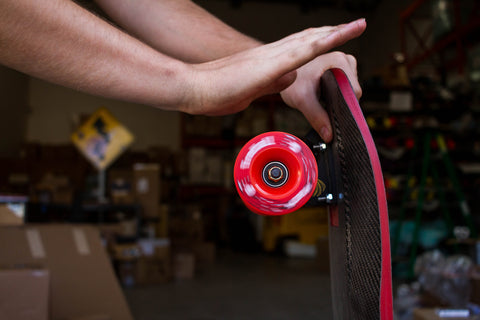
Fast hand spin does not always result in a fast board.
The first instinct we all have when getting our hands on a new bearing/wheel combination is to give the wheels a hard and fast hand spin.
The idea is that if the wheel spins fast, we have a speedy ride. If slow, the bearings suck. This is not always true for one huge reason: lube.
Let me explain.

All materials have microscopic imperfections on their surfaces, even bearings with finest polished steel or ceramic balls.
Lubricant is designed to flow inside of those imperfections and smooth them out.
But not so fast… Despite the smoothing out of the imperfections, lube actually slows down the bearings during a hand spin.
Why does lube slow the bearing down? The lube has mass that has to be moved out of the way while the bearing rotates. During a hand spin, those little balls don’t have much mass behind them to push the lube out of the way.
Thus hand spins are fastest when the bearing has very little or no lubricant.

But what we really want to know is how fast we can skate, not how fast we can hand spin. Enter rider weight, aka load.
When a load is applied to the bearing, the microscopic imperfections we talked about earlier get seriously mashed together. This creates a lot more friction and heat.
Also with load, the balls in the bearing have mass behind them (aka your weight).
So now you have heat from friction, plus more mass that could push lube out of the way.
The solution? Add lube!

Adding lube keeps those imperfections filled and also allows for a fancy thing called laminar flow to occur (laminar flow = a lot less friction).
The lubricant keeps the bearing rolling cooler with less friction, which means longer bearing life.
Take this clip from Indiana Jones as an example. Imagine Indy as the lubricant and the boulder as the ball inside the bearing.

If the boulder was made of styrofoam, Indiana Lube here could just stand arms outstretched and stop the roll. This is what a hand spin is like with properly lubricated bearings (no mass behind the roll).
However, if the boulder was made from solid stone, Indiana Lube is going to get smashed. This is akin to riding on the lubed bearing with your full weight and strong leg push.

As a rider that wants maximum speed and bearing life, a compromise has to be made. You need enough lubricant to properly keep the bearing rolling fast under load, but not so much that it gets in the way and slows the wheel down.

Spacers and Speed Rings are a must for maximum bearing performance.
This leads us to breaking in a bearing.
New bearings require the freshly milled and polished steel balls/races to roll against each other and settle lube into their surfaces.
Once a bearing is ridden a few miles, the surfaces will be completely saturated with lubricant. This almost always makes the hand spins faster.

The last point that I want to make here is the extreme importance of skill. You could have the best gear in the world, but if you don't know how to use it, it's pointless.
Quick story: I was skating with a friend on a very steep hill. I had brand new bearings. He had rusted out bearings. His bearings were so bad, he could point the board straight down the steep grade and it didn't roll away.
Yet he consistently beat me. Why? Because he was a better rider with better form and a stronger push.
Put top priority on improving your abilities, then upgrade gear as needed.
Now go forth and tell riders everywhere: Hand spinning is virtually meaningless. The only way to see how fast a bearing will go is by riding it.
If you still have some questions regarding hand spinning or accurate measures of performance for bearings after reading this piece, feel free to shoot us a message directly here to get an answer immediately.



